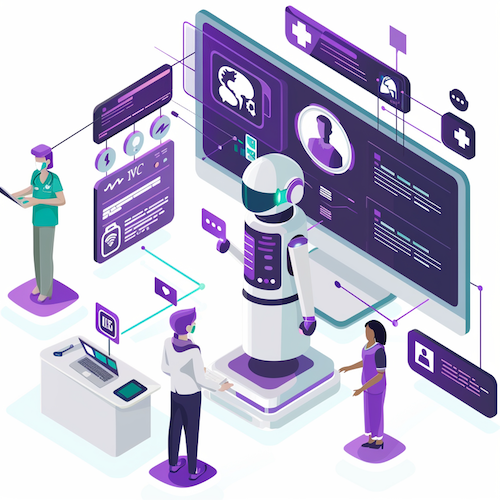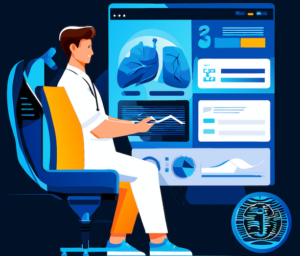Hey there, tech-savvy healthcare leaders! Drowning in a sea of patient data? You’re not alone. The sheer avalanche of medical records can make even the most seasoned professionals feel overwhelmed. But fear not, because AI is here to turn chaos into clarity, revolutionizing the way we handle documentation.
With AI to summarize medical records, you’ll discover how these cutting-edge solutions tackle documentation challenges, enhance operational efficiency, and transform patient care, all while offering actionable insights and practical advice tailored just for you.
Top Takeaways:
- AI medical records summary systems significantly reduce documentation errors, improving accuracy and consistency across healthcare records. This leads to better clinical decision-making and more reliable patient care, directly addressing one of the biggest challenges in healthcare documentation.
- Implementing summarized medical records AI solutions can save healthcare organizations substantial time and money. With AI-driven tools, documentation time can be cut by up to 51% (or even more in some cases), freeing up valuable resources and reducing operational costs.
- Medical record summary AI systems are not just about efficiency—they also enhance regulatory compliance. By standardizing documentation and providing comprehensive audit trails, AI helps healthcare organizations meet stringent regulations like HIPAA, mitigating risk and ensuring data security.
Table of Contents:
- What is Summarization of Medical Records?
- Strategic Imperatives: Why Summarize Medical Records?
- The Hidden Costs of Poor Documentation
- AI-Driven Approaches to Medical Records Summarization
- Building and Implementing an AI Medical Records Summarization System
- Overcoming Implementation Challenges of Summarizing Medical Records
- Practical Tips for Using Generative AI for Summarizing Health Notes
- Cost Considerations and ROI Projections
- Future Trends in AI for Healthcare Documentation
- How Topflight Can Help
What is Summarization of Medical Records?
Let’s break it down. Medical records summarization is all about distilling those mountains of patient data into neat, digestible nuggets of actionable insights. Traditionally a manual and time-hogging endeavor, this task is now getting a high-tech makeover thanks to artificial intelligence. Think of it as your new, super-efficient data assistant.
With AI’s wizardry, complex algorithms and machine learning techniques dive headfirst into the sea of patient data—clinical notes, lab results, imaging reports, you name it. The result? Comprehensive yet concise summaries that capture the essence of a patient’s medical journey, cutting through the noise to spotlight what truly matters.
Strategic Imperatives: Why Summarize Medical Records?
If you’re steering the tech ship in healthcare, you’re always on the lookout for ways to optimize and innovate. Enter the AI medical records summary system—your ticket to enhancing operations, elevating patient care, and meeting those ever-demanding regulations head-on.
Enhancing Operational Efficiency and Reducing Costs
Bringing AI into the fold for medical record summaries is like turbocharging your efficiency. According to Accenture, AI could save the U.S. healthcare system a whopping $150 billion annually by 2026. Here’s why AI-powered summarization is a game-changer:
- Time savings: AI can whip through medical records faster than any human, freeing up your team to focus on what really matters.
| A feasibility study highlighted that an AI co-pilot could cut consultation times by 51%, all while enhancing documentation quality, especially for those navigating unfamiliar EHR systems. |
- Resource allocation: Let AI handle the routine, so your people can tackle the complex and critical tasks.
| The MIT and GE Healthcare survey shows that 60% of AI-equipped medical staff expect to spend more time on procedures rather than paperwork, with 68% noting increased collaboration across clinical areas. |
- Reduced errors: An AI medical records summary system can dramatically cut down on documentation mistakes, potentially saving billions in error-related costs.
| Recent research suggests that AI systems can cut down adverse drug events (ADEs) by 25% to 40% through better medication reconciliation and dosage optimization. |
Incorporating AI into healthcare mobile app design not only improves documentation but also enhances operational efficiency, ensuring that healthcare organizations stay ahead in a competitive landscape.
Improving Clinical Decision-Making and Patient Care
AI-driven medical summaries mean clinicians get the info they need, right when they need it, enhancing decision-making and patient outcomes:
- Comprehensive patient view: AI gathers data from all corners to paint a complete picture of a patient’s health.
- Real-time insights: With AI, summaries update as new info rolls in, ensuring clinicians are never out of the loop.
- Identifying patterns: AI spots subtle trends in a patient’s medical history that might slip through human review, leading to earlier interventions or spot-on diagnoses.
| A survey by MIT Technology Review and GE Healthcare found that 75% of medical professionals using AI reported improved predictions in disease treatment outcomes. |
Addressing Compliance, Risk Management, and Regulatory Requirements
In the world of healthcare regulations, AI medical notes summary tools are your best ally:
- Standardized documentation: AI ensures summaries meet all regulatory and policy standards to a T.
- Audit trails: Keep track of who accessed what and when, staying compliant with privacy laws like HIPAA.
- Risk identification: AI can pinpoint potential compliance hiccups or risky patients, letting you tackle issues before they escalate.
| A report from Pew Charitable Trusts highlighted that patient-to-record matching accuracy can be as low as 80% in a single care setting and as low as 50% when sharing records across organizations. |
Read more on how to automate clinical notes.
Supporting Medical Research
AI-powered medical record summaries are a boon for medical research:
- Data aggregation: Compile and anonymize data in a flash for large-scale studies.
- Hypothesis generation: By spotting patterns across records, AI helps researchers develop new lines of inquiry.
- Clinical trial matching: AI identifies ideal candidates for trials, accelerating drug development.
Implementing an AI medical records summary system isn’t just a nod to modern tech—it’s a must-do for healthcare organizations aiming to excel in a competitive, regulated world.
Reducing Staff Burnout
One of the biggest challenges in healthcare today is the time-consuming nature of medical record management. Providers are bogged down with administrative tasks, stealing precious time from patient care.
| In the Medscape Physician Burnout & Depression Report 2024, 62% of physicians cited bureaucratic tasks, including documentation and medical records management, as the primary cause of burnout. |
This isn’t just an inconvenience—it’s a crucial factor affecting the quality of healthcare and the well-being of providers.
Unanticipated Benefits: Enhanced Patient Engagement
AI-driven summarization can also boost patient engagement and understanding, although it’s not always the primary focus. Sharing concise, clear summaries with patients aids their comprehension of their health status and treatment plans. This transparency fosters better patient compliance and satisfaction with treatment regimens.
The Hidden Costs of Poor Documentation
We all know that AI-powered medical record summarization is a game-changer, but let’s not overlook the heavy toll poor documentation takes on healthcare organizations:
Revenue Loss
Inadequate medical record summaries can bleed your organization dry, with denied claims being a major culprit. A 2017 report highlighted that out of $3 trillion in claims, $262 billion were initially denied. That’s nearly 9% of claims. Sure, about 63% of these denials can be clawed back, but at a hefty $118 per claim appeal cost.
Incomplete or inaccurate records are a fast track to denials, downcoding, and delayed payments, draining time and resources in the process. Even a slight uptick in denied claims can cost a mid-sized hospital millions annually.
| Medical billing blunders are costing the US healthcare industry a jaw-dropping $935 million every week, with poor clinical documentation to blame for 44% of this mess. That’s $411 million vanishing weekly! |
Source: Market data report by Gitnux
Patient Dissatisfaction
Lousy medical record summaries don’t just hit your wallet—they hit patient satisfaction and care quality by causing treatment delays, repeated tests, and miscommunication among healthcare providers.
And as you’re well aware, trust plays a big role here. Studies show patients’ trust in their doctors’ confidentiality influences how much they’re willing to share, and trust in competence affects their views on electronic information sharing.
Before selecting an AI model, reviewing a guide on how to build a doctor appointment app can help ensure your technology aligns with patient scheduling and other essential healthcare workflows.
AI-Driven Approaches to Medical Records Summarization
By harnessing cutting-edge medical record summary AI technologies, we can revolutionize how healthcare providers interact with and leverage patient data.
Natural Language Processing (NLP) Techniques
NLP is at the heart of AI-driven medical record summarization, empowering AI models to grasp and interpret the often messy world of unstructured medical text, like clinical notes and patient histories.
Key NLP techniques in medical record summary AI include:
- Named Entity Recognition: Pinpoints and categorizes medical entities (e.g., diseases and treatments.
- Semantic Analysis: Understands the context and connections between medical concepts.
- Text Summarization: Crafts concise summaries from lengthy medical documents.
Read more on medical document automation.
Machine Learning Models for Context Understanding
Machine learning models are pivotal in providing context-aware analysis of health records. These learning models detect patterns and correlations that might slip past human eyes.
Applications include:
- Predictive Analytics: Anticipating health risks based on historical data.
- Anomaly Detection: Spotting unusual patterns in patient records.
- Classification: Categorizing medical conditions or treatment outcomes.
Leveraging AI in medical billing and coding alongside AI-driven summarization provides a comprehensive approach to managing healthcare documentation, ultimately improving accuracy and streamlining workflows.
Hybrid AI Systems for Comprehensive Summarization
Hybrid AI systems blend rule-based approaches with machine learning for more robust and precise medical record summaries. This mix capitalizes on the strengths of both deterministic and probabilistic models. Benefits include:
- Improved Accuracy: Combining multiple AI techniques minimizes errors.
- Flexibility: Adapts to various types of medical data and documentation styles.
- Enhanced Interpretability: Rule-based components provide transparency that pure learning models may lack.
Explainability in AI-Driven Summarization
Transparency in AI decision-making is crucial in healthcare. Explainable AI techniques help providers understand how the AI model arrives at its conclusions.
Key aspects include:
- Feature Importance: Highlights which medical record elements influenced the summary most.
- Decision Trees: Visualizes the AI’s decision-making process.
- Confidence Scores: Shows the AI’s certainty in its recommendations.
The Role of Deep Learning and Neural Networks
Deep learning models, such as convolutional and recurrent neural networks, are expanding what’s possible in medical record summarization. Applications include:
- Image Analysis: Extracting crucial information from medical images.
- Temporal Data Processing: Understanding the chronology in patient histories.
- Multi-modal Integration: Combining text, images, and sensor data for comprehensive summaries.
Generative AI: The Next Frontier in Medical Record Summarization
Generative AI, especially large language models, offers new opportunities for medical record summarization. These models can generate human-like text, creating more nuanced summaries.
- Crafting summaries that are readable and intuitive.
- Adjusting summary detail based on role-specific needs.
- Producing summaries in multiple languages for diverse populations.
While promising, generative AI models require careful tuning to ensure accuracy in healthcare.
When considering AI integration, following a doctor-on-demand app development guide can provide valuable insights into creating user-friendly interfaces that improve clinician adoption and patient engagement.
Building and Implementing an AI Medical Records Summarization System
For healthcare tech leaders, launching an AI medical record summary system is a game-changing initiative that demands careful planning and execution. Let’s walk through the crucial steps and considerations to ensure your organization fully leverages this cutting-edge technology.
Assessing Organizational Readiness and Defining Objectives
Before diving into the implementation, it’s essential to evaluate your organization’s readiness for an AI-driven medical records summarization system. Focus on:
- Current infrastructure and tech stack
- Data quality and standardization
- Staff technical skills and adaptability to new technologies
- Budget and resources available
With readiness assessed, set clear objectives for your AI medical records summary project, such as:
- Cutting documentation time by X%
- Boosting decision-making accuracy by Y%
- Raising patient satisfaction scores by Z points
Defining specific, measurable goals will guide your progress and mark success benchmarks.
Key Steps in Developing an AI-Driven Summarization Tool
Developing your AI medical note summary tool involves several critical phases:
- Data Preparation: Collect and clean medical records to ensure they’re AI-ready.
- Model Selection and Training: Choose and train AI models on your data.
- Integration Planning: Plan how the AI tool will fit with existing systems and workflows.
- User Interface Development: Build a user-friendly interface for healthcare professionals.
- Testing and Validation: Thoroughly test for performance, accuracy, and usability.
- Deployment: Begin with a pilot program, then scale up.
- Ongoing Monitoring and Improvement: Continuously monitor and refine the system based on feedback.
Integrating your AI summarization system with existing platforms, such as through EHR data migration development, is crucial to ensure seamless data flow and system interoperability.
Selecting the Right AI Technology Stack
Choosing a suitable technology stack is vital for your AI medical record summary system’s success. Consider:
- NLP Libraries: Tools like spaCy or NLTK for processing medical text.
- Machine Learning Frameworks: TensorFlow or PyTorch for AI model development.
- Generative AI APIs: OpenAI APIs (e.g., GPT-4), LaMDA, or Cohere’s for advanced language models.
- Cloud Infrastructure: AWS, Google Cloud, or Azure for scalability.
- Data Storage Solutions: HIPAA-compliant databases.
- API Management Tools: For seamless EHR system integration.
By implementing advanced technologies, you can make AI summarize medical records, significantly enhancing efficiency and accuracy in healthcare documentation processes. Prioritize technologies that support healthcare-specific needs and comply with regulations.
Choosing the Right Foundational AI Model
Selecting and fine-tuning the right AI model is crucial for an effective system:
- Start with pre-trained models focused on medical language, like BioBERT.
- Fine-tune these models using your organization’s medical records.
- Consider ensemble methods for robust performance.
- Update and retrain models regularly to keep up with new medical terms and practices.
Your goal is a model that understands medical jargon and captures your organization’s specific context.
Integration Strategies with Existing EHR Systems
Seamless integration with your EHR systems is key:
- Develop custom APIs for data exchange.
- Use middleware solutions to bridge compatibility gaps.
- Maintain real-time synchronization for up-to-date summaries.
- Ensure minimal disruption to existing workflows.
Work closely with your EHR vendor to ensure smooth integration and regulatory compliance. A successful AI medical record summary system must be integrated seamlessly with existing EHRs, similar to how EHR PointClickCare integration solutions are implemented for optimal performance.
How Long Does It Take to Develop a Medical Records Summary?
Development timelines vary based on complexity, but a typical schedule might be:
- Planning and requirement gathering: 1-2 months
- Data preparation and model development: 3-6 months
- Integration and interface development: 2-3 months
- Testing and validation: 1-2 months
- Pilot deployment and iteration: 2-3 months
- Full-scale rollout: 1-2 months
Total timeline: Approximately 10-18 months
However, using Topflight’s AI development framework and our in-house AI/ML expertise, we can significantly speed up the development of an AI app for EHR summarization. And when it comes to creating a prototype to impress leadership and secure funding, we can nearly cut the estimated timeline in half, thanks to Specode.
Agile Development for AI in Healthcare
Using agile development can significantly boost your project’s success:
- Iterative Development: Break the project into sprints, each delivering functionality.
- Continuous Feedback: Gather user input regularly and incorporate it.
- Flexibility: Adapt to new challenges or opportunities as they arise.
- Cross-Functional Teams: Involve IT, healthcare professionals, and data scientists.
- Frequent Testing: Use continuous integration and testing for early issue detection.
Agile methodologies help ensure your AI medical notes summary system aligns with user needs and organizational goals.
As you implement your AI medical record summary system, consider the entire document processing pipeline, ensuring effective document handling from ingestion to summarization. Explore GenAI technologies for generating comprehensive, contextual summaries, enhancing both efficiency and care quality.
For healthcare systems using Allscripts, exploring Allscripts EHR integration can provide critical insights into maintaining data integrity and enhancing clinical efficiency.
Overcoming Implementation Challenges of Summarizing Medical Records
Implementing AI to summarize medical records is a transformative journey that presents its own set of challenges. Navigating these hurdles effectively is key to ensuring successful integration and operation of AI-driven medical record summarization in your organization.
Managing Change and Fostering User Adoption
Introducing AI to summarize healthcare records can shake up established workflows, and managing this change is crucial.
Strategies for success:
- Create a comprehensive change management plan that clearly communicates the benefits of AI-driven summarization to all stakeholders, emphasizing how it will streamline workflows and enhance patient care.
- Provide extensive training and continuous support to users, highlighting the system’s capabilities and its impact on their daily tasks.
- Identify and support “champions” within your organization who can advocate for the new technology and assist peers with adoption.
- Introduce the AI summarization tool gradually, allowing users to acclimate to its capabilities over time.
Leveraging Pilot Programs for Seamless Adoption
Pilot programs are invaluable for testing AI summarization tools in a controlled environment before full-scale implementation.
Human factors add another layer of difficulty in medical record management, especially in terms of training and cognitive load. Training healthcare providers on proper documentation is both time-consuming and often insufficient. The cognitive load on providers due to complex documentation requirements is significant, contributing to inefficiencies in manual summarization and leading to incomplete or inaccurate records, which affects the quality of patient care.
Key considerations:
- Choose a diverse group of users for the pilot, including tech-savvy staff and those less familiar with technology.
- Establish clear objectives and metrics to measure the pilot’s success.
- Collect feedback consistently and refine the system based on user input.
- Leverage the pilot’s successes to build a strong case for wider adoption across the organization.
Choosing the right EHR platform is crucial for the success of your AI summarization project. Learn more about how to choose an EHR system that best fits your organization’s needs.
Addressing Data Quality, Standardization, and Heterogeneity Issues
The effectiveness of AI to summarize medical records hinges on the quality and standardization of input data, which can be complicated by data heterogeneity.
| A 2019 study in the Journal of Medical Internet Research found that an average hospital visit generates about 80 megabytes of data per patient. |
Unfortunately, this information often ends up fragmented across various systems, making it hard to piece together a comprehensive view of a patient’s health history. The sheer volume and scattered nature of the data can cause critical details to be missed, impacting patient care and outcomes.
Approaches to improve data quality and manage heterogeneity:
- Comprehensive Data Audits: Dive deep into your existing medical records to spot inconsistencies, missing pieces, and quality hiccups that might trip up AI performance. A thorough audit sets the foundation for accurate insights.
- Data Cleaning and Standardization Processes: Establish solid data cleaning routines and ensure data formats are consistent across systems before feeding info into the AI. This step is crucial for sharpening the AI’s knack for generating precise summaries.
- Ontology-Based Approach: Work with medical ontologies to build a universal vocabulary and relationship framework for medical concepts. This strategy aids the AI in grasping a variety of relevant information, leading to more accurate and insightful summaries.
- Multi-Modal AI Models: Craft AI models that can juggle diverse data types—whether it’s structured data, freeform text, images, or even audio. This versatility allows for a richer analysis of patient information in any format.
- Data Enrichment: Tap into external medical knowledge bases to enrich and contextualize your data, boosting the AI’s understanding and summarization prowess.
- Continuous Learning: Employ machine learning models that evolve with new data formats and sources. This ongoing learning journey enhances the AI’s capability to handle varied data and maintain high accuracy in summaries.
Addressing data quality and standardization is crucial, especially when working with complex systems such as medical device integration and ensuring seamless data flow between devices and EHRs.
Critical Issues in AI Summarizing Medical Documents
AI-driven summarization of medical records must overcome several critical challenges:
Handling Complex Medical Terms
AI systems must accurately interpret and process complex medical terms to deliver meaningful summaries. Possible solutions include:
- Use domain-specific AI models trained on extensive medical datasets.
- Integrate a medical dictionary or ontology within the AI system to accurately interpret medical terms.
- Continuously update the AI model with new medical terminologies and healthcare concepts.
Integration with Legacy Systems
Many healthcare organizations still rely on legacy systems that may not seamlessly integrate with modern AI solutions. Best integration strategies include:
- Develop custom APIs for seamless data exchange between legacy systems and the AI summarization tool.
- Consider middleware solutions to bridge the gap between old and new systems.
- Gradually phase out legacy systems as part of a broader digital transformation strategy.
It’s essential to consider how to integrate a health app with Epic EHR/EMR when implementing AI-driven summarization tools to ensure compatibility and optimize workflow efficiency.
AI Hallucination
AI hallucination, where models generate plausible but incorrect information, is a concern, especially in healthcare. Mitigation techniques include:
- Implement rigorous validation processes to verify AI-generated summaries against original documents.
- Use ensemble models combining multiple AI approaches to reduce hallucinations.
- Ensure human oversight in the summarization process, particularly for critical medical decisions.
Ensuring Data Privacy, Security, and Compliance
Data privacy and security are paramount when implementing AI to summarize medical records, with HIPAA compliance being crucial.
Key considerations for HIPAA compliance:
- Utilize strong encryption for data both at rest and in transit.
- Establish stringent access controls and authentication protocols.
- Conduct regular security audits and vulnerability assessments.
- Ensure that your AI healthcare app developer or partners are HIPAA-compliant and ready to sign a Business Associate Agreement (BAA).
- Implement detailed logging and monitoring systems to track all access to medical records and summaries.
Additional security measures:
- Use de-identification techniques to remove personally identifiable information from training data.
- Employ federated learning approaches to train AI models without centralizing sensitive patient data.
- Regularly train staff on data privacy best practices and the importance of maintaining confidentiality.
Successfully addressing these challenges will enable healthcare organizations to implement AI to summarize medical records effectively, enhancing operational efficiency, patient care, and decision-making. Notably, the benefits extend beyond healthcare providers.
Legal professionals, for instance, benefit from concise, accurate medical record summaries in cases like medical malpractice or personal injury claims. AI’s ability to quickly process and summarize complex medical information can streamline legal proceedings and improve case assessments.
Practical Tips for Using Generative AI for Summarizing Health Notes
Successfully implementing GenAI while minimizing risks calls for strategic planning and thoughtful execution. Here, we’ll delve into practical tips and best practices for leveraging genAI, aiming for accuracy, minimizing bias, and extracting maximum value from this powerful technology.
Selecting the Right Generative AI Model
Choosing the right generative AI model to summarize medical records AI is crucial:
- Domain-Specific Models: Go for models like BioBERT or ClinicalBERT that are pre-trained on medical data, offering a deeper understanding of medical terminology and context.
- Fine-Tuning Capabilities: Ensure the model can be fine-tuned with your organization’s specific data to enhance accuracy and relevance.
- Scalability: Pick a model that can efficiently handle your organization’s volume of medical records.
Tip: Regularly update your AI model to keep it in sync with evolving medical knowledge and terminology.
Implementing Human-in-the-Loop Processes
Incorporating human oversight remains crucial even with generative AI. Medical professionals should review AI-generated summaries to ensure accuracy and completeness. Establish mechanisms for users to provide feedback on these summaries, which will help refine the AI model. In cases that are complex or unusual, have clear protocols for human intervention.
Tip: Regularly analyze feedback to identify trends and improve your AI model’s performance.
Ensuring Transparency and Explainability
Transparency in AI decision-making fosters trust and encourages adoption. When possible, use interpretable AI models that provide insight into their decision-making processes. It’s beneficial to attach confidence scores to AI-generated summaries to indicate reliability and ensure the AI can link summarized information back to its original medical record.
Tip: Develop user-friendly interfaces that allow healthcare professionals to easily verify AI-generated summaries.
Incorporating medical patient scheduling software into your AI-driven documentation system can streamline patient flow and improve overall healthcare delivery.
Addressing Bias and Fairness
Ensuring fairness in AI summaries is essential for equitable patient care:
- Diverse Development Teams: Assemble a varied team to bring different perspectives to the AI development process.
- Regular Bias Audits: Conduct periodic audits of AI outputs to detect and address biases.
- Fairness Metrics: Use fairness metrics in your AI evaluations to ensure performance equity across patient groups.
Tip: Engage with ethics committees and patient advocacy groups for diverse insights into potential biases.
Balancing Brevity and Completeness
Striking the right balance between conciseness and comprehensiveness is key:
- Customizable Summary Lengths: Enable AI models to generate summaries of varying lengths based on user needs.
- Hierarchical Summarization: Provide high-level summaries with options to delve into detailed information.
- Critical Information Flagging: Train AI to highlight key information that should never be omitted.
Tip: Collaborate with various stakeholders to understand their specific needs for summary length and detail.
To maximize efficiency, your AI solution should be part of a broader medical practice automation strategy, allowing healthcare providers to focus more on patient care and less on administrative tasks.
Continuous Learning and Improvement
To ensure that your AI system for summarizing medical records remains effective, implement systems that continuously collect and integrate user feedback. Regularly monitor performance through KPIs such as accuracy, completeness, and user satisfaction. Schedule periodic retraining sessions with updated data to keep pace with evolving medical practices.
Tip: Consider A/B testing to compare different summarization approaches and optimize your system.
Integration with Existing Workflows
For successful adoption, integrate AI seamlessly into existing medical record review processes:
- EHR Integration: Ensure smooth integration with existing Electronic Health Record (EHR) systems.
- Customizable Outputs: Develop flexible output formats for easy incorporation into clinical workflows.
- Mobile Accessibility: Provide mobile-friendly interfaces for on-the-go access to AI-generated summaries.
Tip: Conduct user experience research to understand healthcare professionals’ interactions with medical records and design your AI interface accordingly.
Handling Special Cases and Rare Conditions
Generative AI might face challenges when dealing with rare conditions or unique cases. Develop or integrate AI models that are specialized for specific medical domains or rare conditions. Implement a flagging system for unusual or problematic cases that require human review. Enhance AI’s performance on rare conditions through ongoing learning.
Tip: Collaborate with specialist physicians to fine-tune AI performance on complex medical conditions.
By following these practical tips, healthcare organizations can effectively leverage generative AI to summarize medical records while minimizing risks and maximizing benefits. The goal is to implement AI in ways that genuinely improve patient care, enhance clinical decision-making, and streamline healthcare operations.
Cost Considerations and ROI Projections
Understanding the financial landscape of implementing AI to summarize medical records is essential. Here’s a concise look at the key financial factors and ROI prospects:
Initial Investment and Ongoing Operational Costs
When considering the financial aspect of leveraging AI for medical record summarization, it’s crucial to account for both initial and ongoing expenses. The initial investment typically covers AI model development or licensing, establishing the necessary infrastructure, and training staff to effectively utilize the technology.
Once operational, ongoing costs come into play, encompassing system maintenance, regular model updates, and potential expenses tied to cloud computing services. These financial considerations are vital for planning and sustaining a successful AI integration.
For organizations concerned with scalability and compliance, incorporating HIPAA-compliant software development practices from the outset can significantly streamline AI implementation and operation.
Projected Timelines for Implementation and ROI Realization
- Implementation Timeline: Typically spans 6-18 months, influenced by the complexity of the organization.
- ROI Timeline: Expect initial returns within the first year, with complete realization possible over 2-3 years.
Long-term Financial Impact on Healthcare Organizations
The implementation of AI in summarizing medical records offers significant long-term financial benefits to healthcare organizations. A noticeable reduction in administrative tasks is expected, leading to enhanced operational efficiency and cost savings.
Moreover, AI adoption can stimulate revenue growth by improving patient care and streamlining billing processes. These advantages contribute to a more financially sustainable healthcare operation, underlining the importance of strategic investment in AI technologies.
Future Trends in AI for Healthcare Documentation
The future of AI in healthcare documentation is promising and fast-evolving. Here’s a sneak peek at emerging trends:
- Multimodal AI for Comprehensive Health Data Integration
AI will increasingly synthesize data from diverse sources—text, images, sensors—for richer patient insights.
- Predictive Analytics and Proactive Patient Care
AI-driven documentation will not only summarize historical data but also forecast future health trends and propose proactive interventions.
- AI-Assisted Clinical Decision Support Systems
By adding AI summarization into clinical decision support system implementation, healthcare providers will receive real-time, evidence-based recommendations. The convergence of AI with promises to revolutionize how real-time data influences patient care and outcomes.
- The Convergence of AI and Genomics
AI documentation will increasingly include genomic data, paving the way for truly personalized care plans and treatment strategies.
How Topflight Can Help
At Topflight, we’re leading the charge in marrying AI with EHR systems to tackle the real-world challenges healthcare organizations face. One of our standout achievements is GaleAI, a groundbreaking product that harnesses sophisticated AI for medical coding. This solution fits seamlessly into complex EHR platforms, boosting coding precision and financial outcomes significantly.
Take this: during a retrospective audit, GaleAI revealed approximately $1.14 million in annual revenue loss due to undercoding, with human methods missing 7.9% of the codes our AI nailed. This is just a glimpse of how our AI-driven strategies can revolutionize medical records management, ensuring no stone is left unturned.
Our AI development framework, Specode, further amplifies our capacity to craft custom AI medical records summarization solutions. Specode accelerates development and iteration, allowing our partners to swiftly navigate the evolving healthcare tech landscape. It excels in creating scalable, secure, and compliant AI solutions that mesh smoothly with current EHR systems, enabling effortless deployment of AI tools for medical records summaries.
Get in touch with one of our experts today. Let us assist you in spearheading the future of AI medical records summary innovation.
[This blog was originally published on 10/9/2024 but has been updated with more recent content]
Frequently Asked Questions
How does AI summarization improve the accuracy of medical records?
AI summarization enhances accuracy by reducing human error and ensuring consistency in documentation. By leveraging advanced algorithms, AI can process vast amounts of data quickly, extracting essential information and cross-referencing with existing records to maintain accuracy. This leads to more reliable medical records that support better patient care and clinical decision-making.
What technologies are used in AI summarization of medical records?
AI summarization utilizes a blend of technologies such as Natural Language Processing (NLP), Machine Learning (ML), and deep learning models. These technologies work together to understand and interpret medical data, transforming complex text into concise summaries. NLP helps in interpreting the nuances of medical language, while ML models refine their accuracy through continuous learning from new data inputs.
Can AI summarization handle complext medical terminologies and patient histories?
Yes, AI summarization is equipped to handle complex medical terminologies and detailed patient histories. It does so by using domain-specific models trained on extensive medical datasets, which are capable of understanding and accurately representing specialized terms and long patient histories. This capability ensures that critical details are not lost in translation, supporting comprehensive patient care.
How does AI summarization integrate with existing EHR systems?
AI summarization integrates with existing Electronic Health Record (EHR) systems through APIs and middleware solutions that facilitate seamless data exchange. This integration allows for real-time summarization of records within the EHR interface, ensuring that healthcare providers have access to the most up-to-date and accurate information without disrupting current workflows.
What are the privacy and security measures for AI in medical records summarization?
AI in medical records summarization employs robust privacy and security measures to protect sensitive patient information. These include data encryption, access controls, and compliance with healthcare regulations such as HIPAA. Additionally, continuous monitoring and regular security audits are conducted to ensure data integrity and prevent unauthorized access. AI systems also incorporate de-identification techniques to anonymize data, further safeguarding patient privacy.







